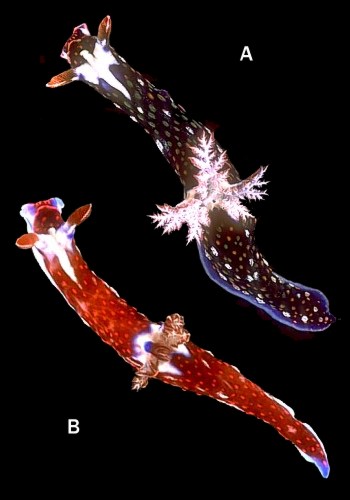
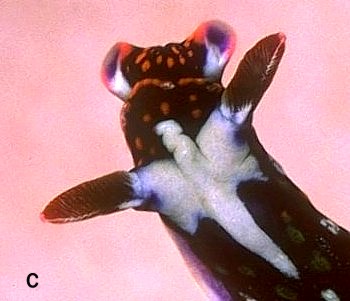
Nembrotha livingstonei
Allan, 1933
Order: NUDIBRANCHIA
Suborder: DORIDINA
Family: Polyceridae
Subfamily: Nembrothinae
DISTRIBUTION
Described from Eastern Australia. Probably has a wider Indo-West Pacific distribution.
PHOTO
A., Heron Is, Queensland, September 1984, 48mm long alive, B., Coffs Harbour Region, New South Wales, December 1990, 19mm long alive. C. Head of upper animal showing oral lappets and characteristic white mark between rhinophores. PHOTOS: Bill Rudman.
It is characterised by a dark reddish brown to dark green or black body with orange, reddish brown, green and white spots. There are distinctive cross-like white patches, outlined in blue, around the gill pocket, and between the rhinophores. In one specimen from eastern Australia many of the spots are green rather than orange. It was previously known from western Australia and the Great Barrier Reef.
Reference:
• Allan, J. (1933). Opisthobranchs from Australia. Records of the Australian Museum, 18: 443-450.
Rudman, W.B., 1999 (August 22) Nembrotha livingstonei Allan, 1933 . [In] Sea Slug Forum. Australian Museum, Sydney. Available from http://www.seaslugforum.net/find/nemblivi
Related messages
Nembrotha livingstonei in the Andaman Sea?
February 14, 2008
From: Christian von Damm
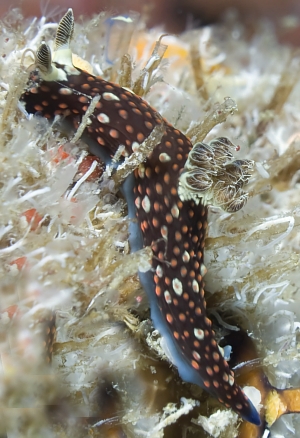
Dear Bill,
about two weeks ago i found a Nembrotha sp. wich I have never seen before. It seems to be a Nembrotha livingstonei. I work on a Liveaboard at the Similan Islands, Thailand. Definitely a rare find in in our area.
Locality: Similan Islands, Tuna Wreck, 33 meters, Phang Nga, Thailand, Andaman Sea, 20 November 2007, Piece of Rope on a small Trawler Wreck. Length: 50 mm. Photographer: Jeffrey Davies.
I would be very grateful if you could confirm the species.
Best regards
Chris von Damm
chrisvondamm@gmail.com
von Damm, C. , 2008 (Feb 14) Nembrotha livingstonei in the Andaman Sea?. [Message in] Sea Slug Forum. Australian Museum, Sydney. Available from http://www.seaslugforum.net/find/21286Thanks Chris,
Although it lacks the characteristic white marks between the rhinophores, I would agree with your identification.
Best wishes,
Bill Rudman
Is this a variationNembrotha livingstonei ?
July 6, 2007
From: Colin Teo
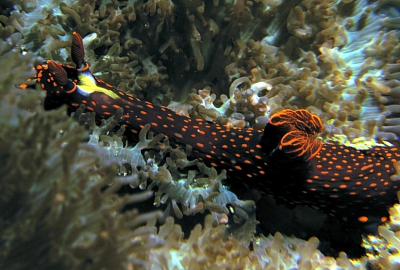
Hi Bill,
Can you confirm? Looking at the fact sheet, it says the Nembrotha livingstonei is characterised by a white mark between the rhinophores but this has a yellow patch.
Locality: Malapascua, 9 m, Philippines, 23 February. Length: 6 cm. Photographer: Colin Teo.
Colin Teo
colin_teo@yahoo.com
Teo, C., 2007 (Jul 6) Is this a variationNembrotha livingstonei ?. [Message in] Sea Slug Forum. Australian Museum, Sydney. Available from http://www.seaslugforum.net/find/19693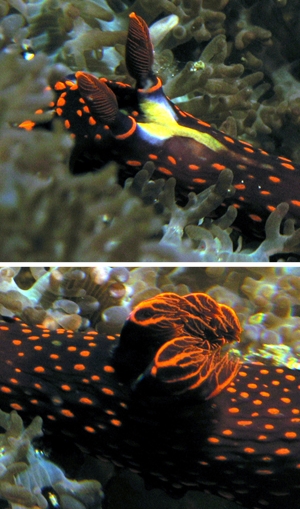
Dear Colin,
This group of Nembrotha species still has some sorting out to do, but my feeling is that all these animals with a white - or yellowish - cross mark between the rhinophores will turn out to be the same species.
Best wishes,
Bill Rudman
Nembrotha livingstonei from Imdonesia
December 17, 2002
From: Jim Bartlett
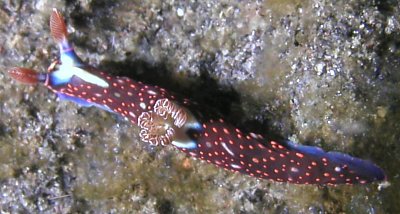
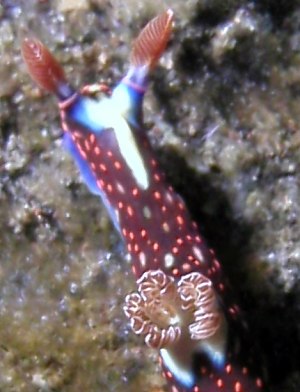
Bill,
Here's another Indonesian sea slug I wasn't able to identify from a borrowed book. I also didn't come across photos of creatures identical to it during my scans through the site, though I may have missed it.
This nudi was observed on Mentjeng Wall off of Sanjeang Island near Komodo. The gills seem very unusual to me...like coils of thin radio wire. I estimate the specimen was about 4cm in length; depth was about 12 meters, and time photographed was about 11am local, Nov. 13th 2002.
Thanks for any advice you may have on this one.
Jim Bartlett
jim_bartlett@pinnicle.com
Bartlett, J., 2002 (Dec 17) Nembrotha livingstonei from Imdonesia. [Message in] Sea Slug Forum. Australian Museum, Sydney. Available from http://www.seaslugforum.net/find/8507Dear Jim,
This is what I am calling Nembrotha livinstonei. The size and colour of the spots seems to be variable but the cross-like mark between the rhinophores seem constant
Best wishes,
Bill Rudman
Nembrotha livingstonei from the Philippines
July 4, 2001
From: Erwin Köhler
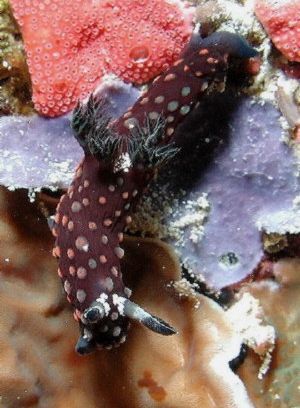
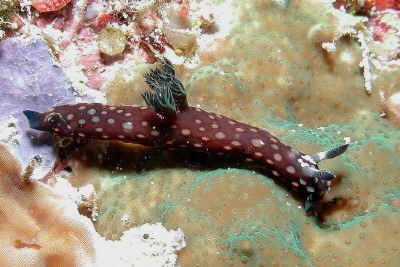
Dear Bill,
Here is the next one from to the Philippines, Cebu Island, Moalboal, divesite "Dolphin House", depth 37 m, length 48 mm, May 27, 2001.
Erwin
Erwin@medslugs.de
Köhler, E., 2001 (Jul 4) Nembrotha livingstonei from the Philippines. [Message in] Sea Slug Forum. Australian Museum, Sydney. Available from http://www.seaslugforum.net/find/4591Dear Erwin,
I am pretty sure this is Nembrotha livingstonei. It lacks some of the white markings on the body but those that it does have fit with those in more typically coloured animals.
Best wishes,
Bill Rudman
Nembrotha livingstonei - different colour forms
September 5, 1999
From: Julie Marshall
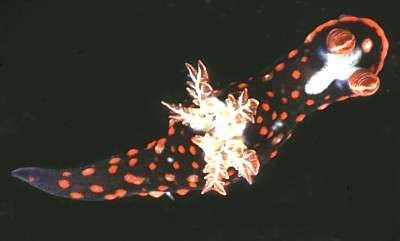
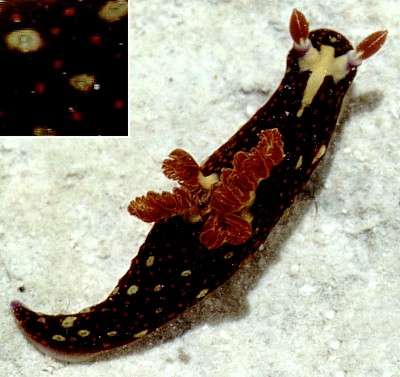
Dear Bill,
Last week several colour forms of Nembrotha livingstonei were illustrated on your Forum, in your answer to a question from Japan. Attached are two other variations found at Heron Island, Great Barrier Reef. I have found over 20 specimens of this species at Heron Island ranging from 10 mm to 60 mm. Whilst most of the animals are the same as the animal you illustrated as specimen A, a couple of my animals had a bright yellow cross-shaped patch between the rhinophores rather than white. The other animal differs more markedly having a dark green body and prominent orange pustules. The patch round the gills and the cross shaped patch between the rhinophores is a very pale greyish-green. This animal was 10 mm and was found in November 1998 on bryozoans attached to a grid protecting a saltwater intake pipe at 13 metres on the south side of Heron Island.
Best wishes
Julie Marshall
j.marshall@latrobe.edu.au
Marshall, J., 1999 (Sep 5) Nembrotha livingstonei - different colour forms. [Message in] Sea Slug Forum. Australian Museum, Sydney. Available from http://www.seaslugforum.net/find/1287Thanks Julie,
I am not 100% sure they are all the same species but certainly the ones I have looked at show no internal anatomical differences.
Bill Rudman.
Nembrotha livingstonei? from Japan
August 24, 1999
From: Atsushi Ono
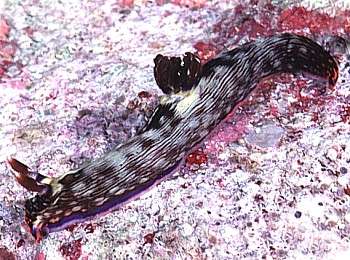
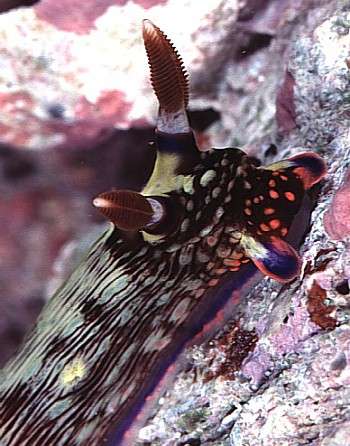
Dear Bill,
Thank you very much for ID of Aeolids.
Now, I found a strange Polycerid from Kerama Island [near Okinawa] in Japan.
This individual is similar to Nembrotha lineolata with many slender lines on body. But it is also similar to Nembrotha kubaryana with red line (small red dot) of edge of foot, too. This animal is about 45mm long, I found this 7m depth.
There are N. lineolata and N. kubaryana here.
Is this a hybrid?
Do a hybrid of Opisthobranchs exist?
Sincerely,
Atsushi Ono
ononini@cosmos.ne.jp
Ono, A., 1999 (Aug 24) Nembrotha livingstonei? from Japan. [Message in] Sea Slug Forum. Australian Museum, Sydney. Available from http://www.seaslugforum.net/find/1220Dear Atsushi,
I think your animal is not a hybrid but probably a colour form of Nembrotha livingstonei. That species in Australia is rather variable in colour and has spots rather than lines. However there are a number of consistent colour characters all the specimens have on common. There is the white cross pattern between the rhinophores and a similar pattern around the gill pocket. And if you compare your photo of the head of the Kerama Island animal with my photo of the head of an Australian animal they are identical.
I am sure some will disagree and I have not seen the radula of your animal, but the radula of orange, green and black animals from Australia have an identical radular morphology. your animal retains the greenish spots at the anterior end of the dorsum, and also down the sides of the body.
Concerning hybridisation. I have seen no evidence of hybridisation. It is a difficult question, because what may look like two species hybridising may be just two colour forms of the same species. We still have a bit to learn about the species of Nembrotha. Look at the messages about Nembrotha rutilans and similar coloured species, and the red-spotted Nembrotha species, to see what I mean.
Best wishes,
Bill Rudman.
